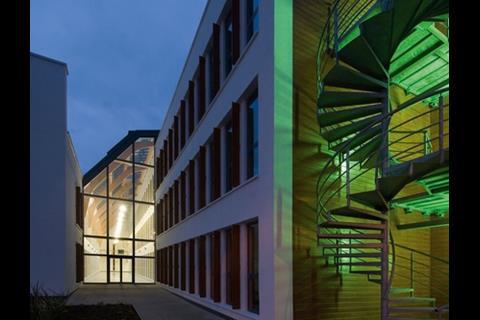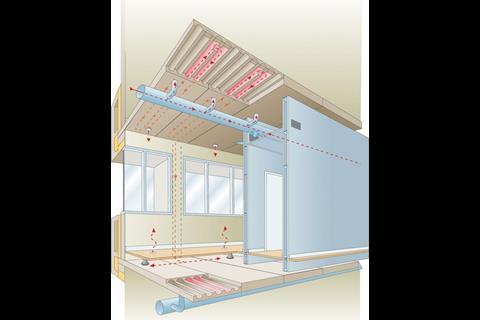Integrating structures and services to get the most out of thermal mass can be a good road to lower energy consumption. Stephen Kennett looks at Tarmac’s solution
At 160 Tooley Street, the design team decided to integrate the structure and building services to take advantage of the building’s thermal mass and simplify the way that ventilation air was distributed down through the building.
This idea of exploiting thermal mass and integrating structure and services was also the key concept behind TermoDeck, an off-the-shelf system from Tarmac. Described as a fan-assisted cooling, heating and ventilation system, it uses hollow-core concrete floor slabs – supported on a concrete, steel or even timber structural building frame – to distribute the fresh air around the building and lower energy consumption.
How it works
Like the Tooley Street scheme, the TermoDeck system relies on the concrete slabs being left exposed. The thermal mass of the concrete is then harnessed in three ways.
First, heat is stored in – or kept out of – the concrete to vary its temperature. So, while the outside air temperature might fluctuate during the day, the inside remains stable with fewer peaks as the concrete soffits absorb or emit heat. This is known as thermal lag.
Second, as the hollow core slab forming the ceiling soffit is exposed, up to 70% of the room’s heating or cooling is from the radiant effect. In other words it directly heats or cools the occupants rather than the air in the room, which is more efficient.
Finally, as the air passes through the hollow core slab and comes into contact with the concrete, exchange of heat takes place, meaning that fresh incoming air can be introduced into the space with less need for mechanical heating and cooling.
Seasonal adaptation
The supply of air is controlled by the building management system. In the summer, the idea is that at night, the fans draw the cool outdoor air into the hollowcore slabs, lowering the temperature of the building – free night cooling. Then, during the day, warm air that enters the building is cooled as it passes through the hollowcore slabs. The high thermal mass of the exposed ceiling soffit also absorbs internal heat gains generated from lighting, equipment, people and solar gains.
In the winter, the heat absorbed by the concrete slabs warms the fresh incoming air. Where necessary, a heating unit may be used to provide additional heat. During the night, the system is closed off and the heat stored in the concrete soffits is gradually released to the internal spaces.
Planning for TermoDeck
The hollow core planks themselves come in standard sizes which are cut and modified on site to meet the building’s layout.
As TermoDeck is an integral part of a building‘s structure it needs to be considered at the early stages of design. It also requires the building to be modelled to predict temperatures in the occupied spaces and to ensure that the system is feasible – this involves accurate assumptions about the building’s occupancy and usage.
Specifier 17 October 2008

- 1
- 2
- 3
- 4
- 5
- 6
- 7
- 8
- 9
- 10
 Currently
reading
Currently
reading
The alternatives: Thermal mass
- 12








































No comments yet